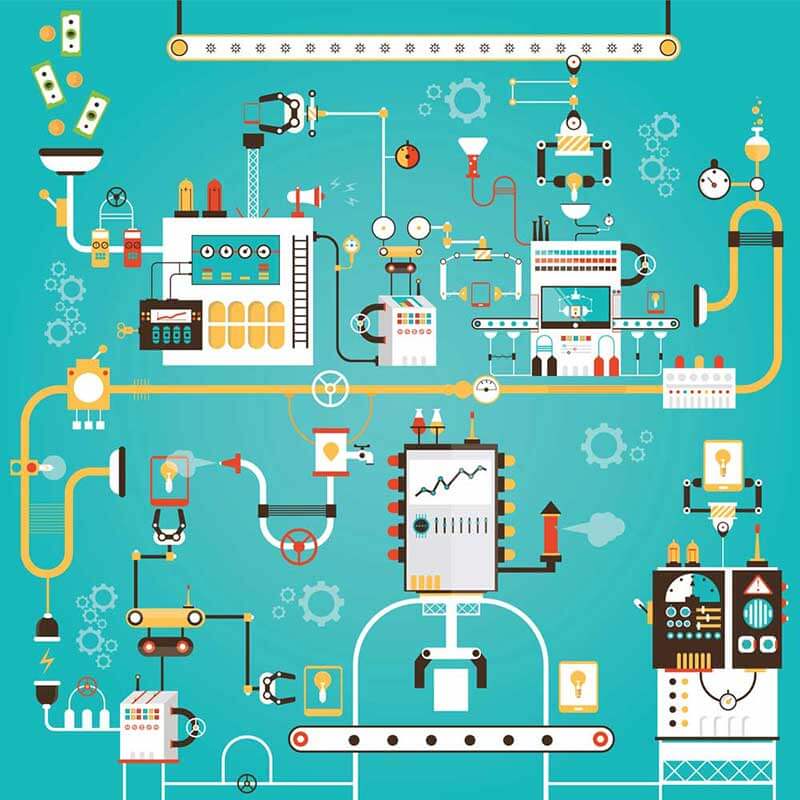The factory of the future… what would it look like? Clean and brightly illuminated? A paradise of zero defect, zero downtime and zero wastage? Will it be an organised place where information and production are all interconnected? Will it be an efficient place where global teams of knowledgeable employees, smart machines, analytics, dynamic systems and clients work together across the entire supply chain? This picture of perfect integration of high-tech employees and equally high-tech tools and machinery is quite different from the dirty, dark factories in the past. Even though this may seem more like a dream, the reality of the factory of the future may be just around the corner.
Smart manufacturing and disruptive technologies. What exactly is happening?
The definition of a smart factory is as fluid as the technology that drives it. In a smart factory, high-speed disruption, human ingenuity, technology and information are married to revolutionise the way manufacturing intelligence is implemented into all aspects of business; disrupting every component of the value chain: how products are developed, the way they are manufactured, in what manner they are shipped and the way in which they are marketed and sold. In the smart factory of the future, worker safety will have improved and environments will be protected by zero carbon emissions. Within this decade, these transformations, driven by smart manufacturing technologies, will revolutionise the worldwide competitive marketplace in three phases:
Phase 1
All manufacturing data will be integrated across plants and enterprises, resulting in significant cost reduction and improvements in environmental impact and safety in the workplace.
Phase 2
This manufacturing data, in combination with digital modelling and simulation, will result in strong ‘manufacturing intelligence’; facilitating flexible manufacturing processes with the best possible production rates and increased possibilities in terms of product customisation.
Phase 3
The growth of intelligent manufacturing will inspire product and process innovations, defining what smart manufacturing stands for: market disruptions such as a car that only costs $ 2500. Countries and manufacturing companies that jump on the bandwagon and start preparing and working towards smart manufacturing will be the first to achieve competitive advantages for decades to come.
Industry 4.0
The first industrial revolution made the mechanisation of production processes possible through harnessing of steam power, making the industry evolve from manual labour-based to predominantly machine-based. The second industrial revolution was ushered in after the Civil War and saw electric power facilitate mass production, leading to exponential economic growth. In the third industrial revolution, IT and electronics further automated production processes. Industry 4.0 will see a move to digitisation and connected machines and work systems, creating intelligent networks across the entire value chain that have the capability of controlling each other autonomously. Change is coming, and it’s coming at us like a cyclone. The next milestone moment is said to be 2020, some point to 2030 while others look to 2050. Will we finally be able to shake the image of dirty, dangerous, labour-intensive workplaces? It will be interesting to witness the effects it will have on our future.
Video credits: Pilz_INT
Smart factory concept studies and tests
There are many smart factory concept studies underway at the moment and some of them are undergoing trials across various industries. Concepts such as automation in logistics, virtual reality testing areas, newly developed product properties as well as sustainability are among those concepts tested, as we can see from the examples below:
Automated logistics
The focus areas of many robotic initiatives are automated logistics as well as production and packaging. The EU Pan-Robotic initiative, for instance, is aiming at the use of robots for the improvement of supply warehouse operations. In this project, engineers use lasers, on-board cameras, 3D mapping and smart systems in order to improve various warehouse processes. This is done by creating robots that are more efficient, faster and safer than the manual operations and current robotic systems combined.
Virtual reality
With the help of virtual reality, the early stages of design and development can be used for engineers to test out new production processes. For instance, the Chemnitz E3-research factory concept of the future, developed in collaboration with Volkswagen AG, makes use of virtual reality technology for testing factory settings so that workers can explore and learn – this has been done through the adaptation of one of the actual production lines so that research can be done in a virtual reality setting. When the head movement of the employee is detected, the VR environment can switch the view of the factory in such a way that the experience is adapted with each movement.
New product properties
Innovative materials are being used by engineers to explore new product properties. An example is the use of nano-particles in the medical industry. Since nanotechnology is finding its way into the pharmaceutical factories, developing new methods for diagnosis and drugs administering could be revolutionised with the use of nano-particles.
Sustainability
Also in the area of sustainability, new ways are being devised for the incorporation of sustainable methods for, for instance, the re-purposing of waste materials. An example is a sugar beet products factory in Norfolk, England, that has started using heat waste, generated during their production processes, to warm a greenhouse while their carbon-monoxide emissions help with the photosynthesis of the crops in that greenhouse.
See also: The elusive smart city – what is it?
The fusion of the world of industrial production and the online world
One of the first times the term ‘Industry 4.0’ was used, was in a German high-tech strategy document in which a plan was outlined for the computerisation of the manufacturing industry, thereby virtually eliminating the need for human involvement. In January 2015, at the World Economic Forum, German Chancellor Angela Merkel spoke of the concept as a way to deal with the fusion of the world of industrial production and the online world. A staggering 500 million euro will be invested in research across business, academia and government and other countries are following Germany’s lead.
The Smart Manufacturing Leadership Coalition in the United States is an organisation comprising technology firms, manufacturers, government agencies, laboratories and universities. The organisation’s vision is the advancement of Industry 4.0 thinking, by developing an open and intelligent manufacturing base from which manufacturing companies can gain access to industrial-networked information applications for analytical and modelling technologies that can be customised to suit the requirements of these companies. The introduction of smart manufacturing processes will not happen overnight. Once such processes are adopted however, they will lead to more organised, more structured and more efficient manufacturing. As the new, fast-paced smart factories become more and more digitally connected, optimised data collection will be possible from the information transfer across all areas of the supply chain.
The transformation to becoming smart – Siemens, Airbus and Toyota
An excellent example of a smart factory is Siemens. About 75% of the factory is automated. Its roughly 1160 employees spend the most part of their days monitoring production processes from behind their computers and they hardly interact with the machinery. What this factory is doing could very well be what the future of manufacturing will look like. At the BMW plant in North Carolina, new robots are being tested to work side by side with human workers. There couldn’t be a bigger contrast if you compare this scenario with the brutal machinery of the past!
Airbus has identified several lines of production to be optimised by 2020, one of which is the increased use of automatic techniques for the identification and diagnosis of defects on their production lines. From 2015, they will also incrementally be releasing robotic applications each year, including lightweight robots and small machining systems.
Toyota says it has completely re-thought the way its future car factories will operate. The ‘simple and slim’ factories will be 25% smaller than existing plants, have a 55% lower carbon emissions and require 40% less investment. They will, for instance, be re-engineering their production lines in order to shorten or lengthen them within 80 minutes, allowing them to easily increase or reduce production capacity, depending on the demand. Countries such as Japan, China and South Korea are also taking huge steps to develop global systems to make their factories more intelligent. The rest of the world, however, seems to be rather inactive from this development perspective.
Is your factory ready to join the ranks of the leaders?
One key characteristic of the factory of the future is an absolutely essential one: a creative mindset for out-of-the-box thinking and problem solving. This is necessary for embracing revolutionary, even disruptive technologies. Manufacturers that adhere to ‘tried and tested’ manufacturing processes will cause serious road blocks for themselves and their entire value chain. The ones who are leading the way with and to smart manufacturing processes are making courageous moves and will be reaping the rewards; is your factory ready to join their ranks?
Share via:




